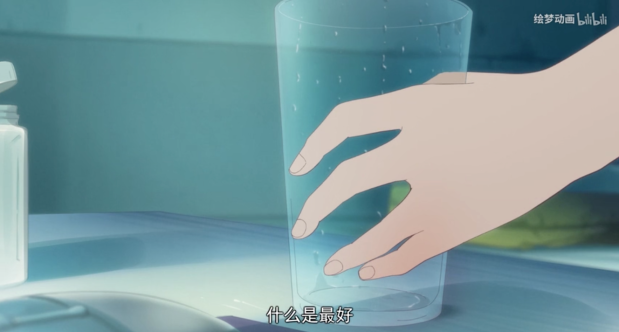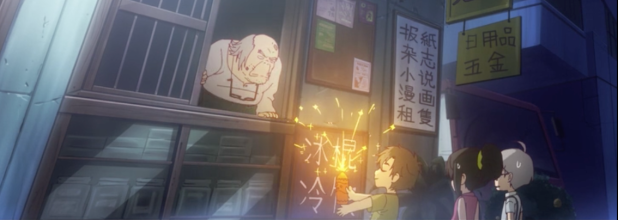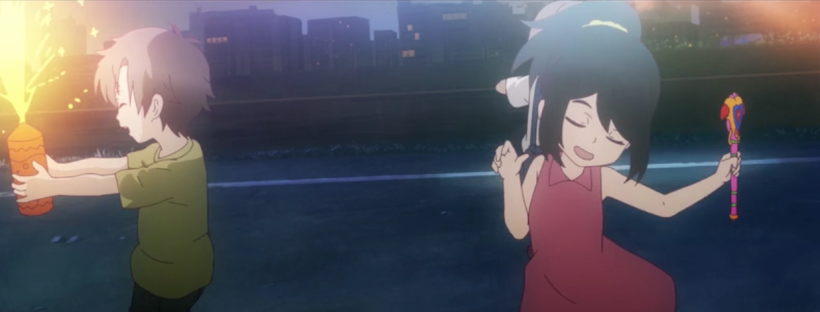To Be Hero LEAF (also known as “To Be Heroine” in the Japanese localization) is a donghua [1] that sucked me into its world as soon as I first encountered it. It is packed full of allusions, metaphors, puns, and powerful messages, many of which I found to be very masterfully done from a storytelling perspective, and this is coming from somebody is a total guru obsessed with “surreal-type” anime like Mawaru Penguindrum, Tatami Galaxy, and Flip Flappers.
This is the type of story that deserves to have essays picking it apart.
And indeed, while the show was airing, I found myself greedily trying to pick up on the subliminal messages and hints that the creators had left lying around.

Episode 1: Like isn’t that clearly an empty medication bottle on the left? Is the “dream” that Futaba (Xiao Ye) finds herself in really just a dream? …or something more sinister…?
I also took to the Internet trying to see if anyone else had found the show to be as fascinating as I had.
However, I was really surprised to discover that “To Be Heroine” was in fact quite poorly received in the Western anime community. It had basically zero attention, and what little attention it had seemed focused on how they refuse to watch it since Chinese animation sucks and how the Chinese language apparently sounds like vomit.
Ching chang chong, is what she said.
[…]
I am not even sure if the worst part of the series are the dull characters, the awful story, the lackclustery animation or the half-Chinese-half-Japanese voice acting. The Chinese parts sound beyond awful. No one is acting. They just slur out words and it sounds nauseating.
★ ★ ★
Full disclosure: I am Chinese American, and I did in fact watch the show first in Chinese.
The racist comments aside (seriously… ugh), I ended up going back to watch the Japanese dub on Crunchyroll partially because I wanted to know what exactly the majority of the English-speaking anime community was seeing that gave them such a sleezy impression.
And frankly, I was really taken back by what I saw.
The Japanese localization… is so disappointing. It’s honestly just a shoddy “editing” job.
This article by kViN at Sakuga Blog goes into the details, but the Japanese version is so heavily cut that the rhythm and pacing of the show is completely messed up. The comparison videos that kViN posted really makes the difference between the two versions really stark (give it a look if you get a chance!). In their words:
I believe it’s important to get across the scale of the differences to illustrate why the creators are so upset. After only 3 episodes of To Be Heroine, over 11 minutes of content have been cut away. Following this trend, by the end of the series they’ll have removed 1-2 whole episodes’ worth of footage. It’s hard to estimate until the broadcast nears its end, but 15~25% of the runtime will have been cut. This is substantial in and of itself, but it compromises the series even more than you might be thinking. That’s because rather than cleanly cutting away a bunch of work, they’re editing every single scene. Even if you like To Be Heroine as it’s airing in Japan and streaming worldwide – which I do, with the obvious caveats – it should be obvious why the artists behind it are frustrated.
And just like the timing intended by the director has been modified, so have the plans of the rest of the team. Sometimes footage will be literally sped up, screwing with the original timing the animators felt was appropriate for the events. In other occasions the changes are more fundamental, like the hectic battle in the first episode that was fully rearranged in an attempt to hide the fact that some shots were removed outright, compromising the flow of the sequence – never a good idea, but even more questionable in a show where the action animators have been encouraged to storyboard their own sequences. And since modifications this substantial change the nature of the scene, the original sound direction no longer fit either. As a result, To Be Heroine often uses different tracks for those scenes, more often than not neutering the impact. While its predecessor was also edited when it made it to Japan and overseas, this time around the changes have been so intrusive that both the studio and individual animators have openly expressed their concerns. The show people around the world isn’t the one they made, and in many regards it seems undoubtedly worse.
★ ★ ★
Translation is another major topic that is suffering in the Japanese dub.
There are a lot of puns and a substantial amount of cultural references in the Chinese original that make a lot of intuitive sense for Chinese viewers, but are completely lost when dubbed into Japanese and translated a second time into English subs.
…It’s sort of the effect of a translation of a translation.
If I get a chance in the future, I’d like to do more articles on the puns and the cultural context of some of the major themes in the donghua.
For today though, I’ll focus on the Happy Birthday Song in Episode 2 because Crunchyroll never bothered to translate it (presumably because it was never subbed into Japanese in the first place).
In case people never noticed, the version that the kids sing is not actually how the Happy Birthday Song goes in Chinese.
The harmonization aside, they add a whole second verse that is completely original and tailored to the show.
Here’s the lyrics that were never translated:
★ ★ ★
Happy birthday to you, happy birthday to you,
Happy birthday to you, happy birthday to you.
Far away, there are precious memories in my heart, ringing.
The Milky Way’s radiance, blooms by your side, rippling.
Dreams that haven’t changed, protect this moment.
Magic takes me aflight,
Bravely heading in a new direction for you.
★ ★ ★
祝你生日快乐 祝你生日快乐
祝你生日快乐 祝你生日快乐
远方有珍贵的梦在心中回响
银河的光芒绽放在你身旁荡漾
未改变的心愿 守护这瞬间
魔法带我起航
为你勇敢前往新的方向
★ ★ ★

Author’s Notes:
- Donghua (动画): The Chinese term for “cartoons/animation”. Commonly used in the West to refer to “anime” that is made in China.
